TAPAS.network | 15 May 2025 | Commentary | Pete Dyson
Going longer: why we are missing the vital timelines for transport planning, policy and research

Are we looking far enough ahead in transport thinking? In the run up to LTT’s Transport Future 2050 event, considers the need for longer-term thinking in transport policy and research, challenging the values implicit in our current practices, and finding some lessons from history. He sees the opportunity to engage positively with the next generation in exploring what lies ahead, and how to understand and shape the future. Who is already seeking to make that a reality, and how could it be done better, he wonders?
TRANSPORT POLICY talks a good game about long-term thinking, but the horizons are questionable, language is vague, the commitments weak, and our practices generally not up to the task. We’re notably falling short of what past generations delivered, and even more importantly, what future generations might expect from us.
Placing the perilous ambiguity of ‘short’ and ‘medium’ term to one side, past civilizations would surely be underwhelmed to learn that ‘long-term’ in transport circles currently means about only 15-30 years ahead. To transport operators long-term can mean just a few quarters or years away, with ‘long-term contracts’ typically just 5-9 years (like the train operator and bus franchise periods). True, some local authority long-term plans extend to 15 years ahead, and while the UK Government’s Treasury Green Book guidance on infrastructure development goes a bit further, in defining long-term as ‘over 30 years’, it typically cuts off counting benefits beyond 60 years.
Past civilisations might well respond “30 years, but that’s just one generation…. barely enough to build a quarter of a cathedral!” Talking about long-term thinking isn’t new, but let’s not get tired of it, as we urgently need fresh thinking now. So I want here to refresh the case for thinking longer, the importance of updating the metrics that value the future (discount rates) and to propose adding children, young people and future generations into our forward looking research as a small but significant positive step.
We should look both forwards - and backwards
This year marks the 200-year anniversary of British railways and proves the longevity of infrastructure decisions and the path of dependency from the past that constrains what we can do now; for example, the narrow rail tunnels that now limit the UK to smaller trains. Less ceremonially, Britain’s motorways are now reaching old age, with 80% of their miles now built over 50 years ago, and the oldest about to reach 70. As I’ll explain, they’re already beyond the scope their creators were asked to assess with their costs and benefits, yet its abundantly clear they’ll be used for centuries to come.
Looking forwards, we are now just 25 years from the leading long-term vision that galvanizes transport policy - reaching Net Zero by 2050. This is clearly an urgent objective, but hardly suggests the truly multi-generational grandeur set out by visionaries of the past.
Reconciling these various ‘horizon’ dates begs the question, are we still neglecting the very long-term impact that our railways, roads, tunnels and policies might have for centuries to come? If we chose to value the future more, what might we do differently now? I believe one quick answer is to extend our thinking beyond transport infrastructure itself – roads, bridges, railways and airports –and to the land use choices that will both define where and how future transport goes, and how much people in the future will depend on mobility to maintain their lifestyles.
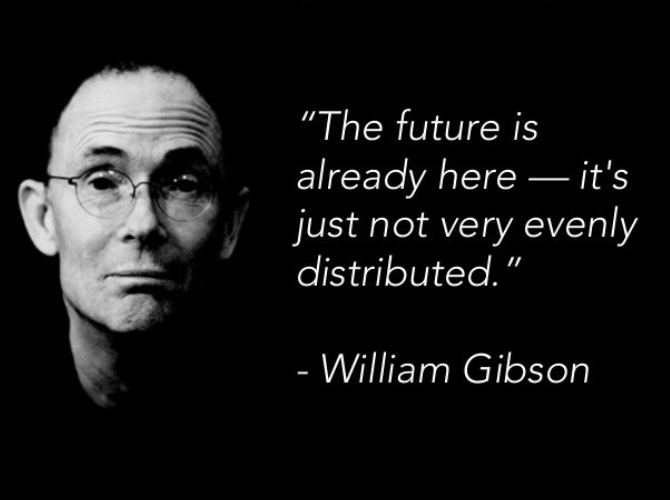
The quote attributed to science-fiction writer William Gibson from the 1990s that “the future is already here, it’s just unevenly distributed” gave rise to a helpful article by Tim Chatterton and Georgia Newmarch in 2016[1] who went further than the spatial geography implied by Gibson (that whizzy technology is out there, just not adopted everywhere yet) to explain the importance of addressing transport-related inequalities, ensuring groups of people in society aren’t being left behind. One way to address this is reforming the metrics that we use to measure the future itself.
Discount rates as they are, holding us back
Discount rates are transport appraisal’s way of counting the value of benefits now, versus their value to people in the future. More technically, according to the Green Book “Discounting in the public sector allows costs and benefits with different time spans to be compared on a common present value basis”. After much deliberation, it was decided that a discount rate of 3.5% per annum applies to future benefits, meaning benefits in 10 years’ time are worth approximately 70% their present value, and in 50 years just 20% of their present value. A special reduced rate of 1.5% per annum however applies to policies that impact health or life outcomes, showing there’s room for flexibility depending on what exactly we’re counting.
Debate on this topic is vast, and I recommend turning to this recent House of Lords summary[2] as a useful grounding, and also this University of Birmingham explainer[3] for a stronger argument in favour of further reform.
Generally, the maximum life span to be counted is up to 60 years, and while I’m not a transport economist, I had hoped the experience of the past, and recent evidence from the present, would have pushed for a longer time window (especially for transformational ‘once in a generation’ type projects). In any case, predictions upon which appraisal is based, may well turn out to be inaccurate, as Professor Phil Goodwin’s work on UK road traffic forecasts has shown (see graph below). From a social and behavioural perspective, the true value of improved transport provision often comes only when people organise their lives around it, and this can take many years, implying and reflecting changes in land use. For this reason, in the spirit of George Hazel’s land-value-capture contention[4] I suggest many new transport policies and technologies, like car clubs and micromobility providers, should examine long-term land values changes in their evaluations of scheme successes. After all, if these schemes improve people’s mobility, and property prices are all about ‘location, location, location’, one measure of success ought to be land values increasing in their vicinity. By contrast, if they are a novelty people think they cannot depend upon, then it is unlikely to be reflected in any long-term land value change.
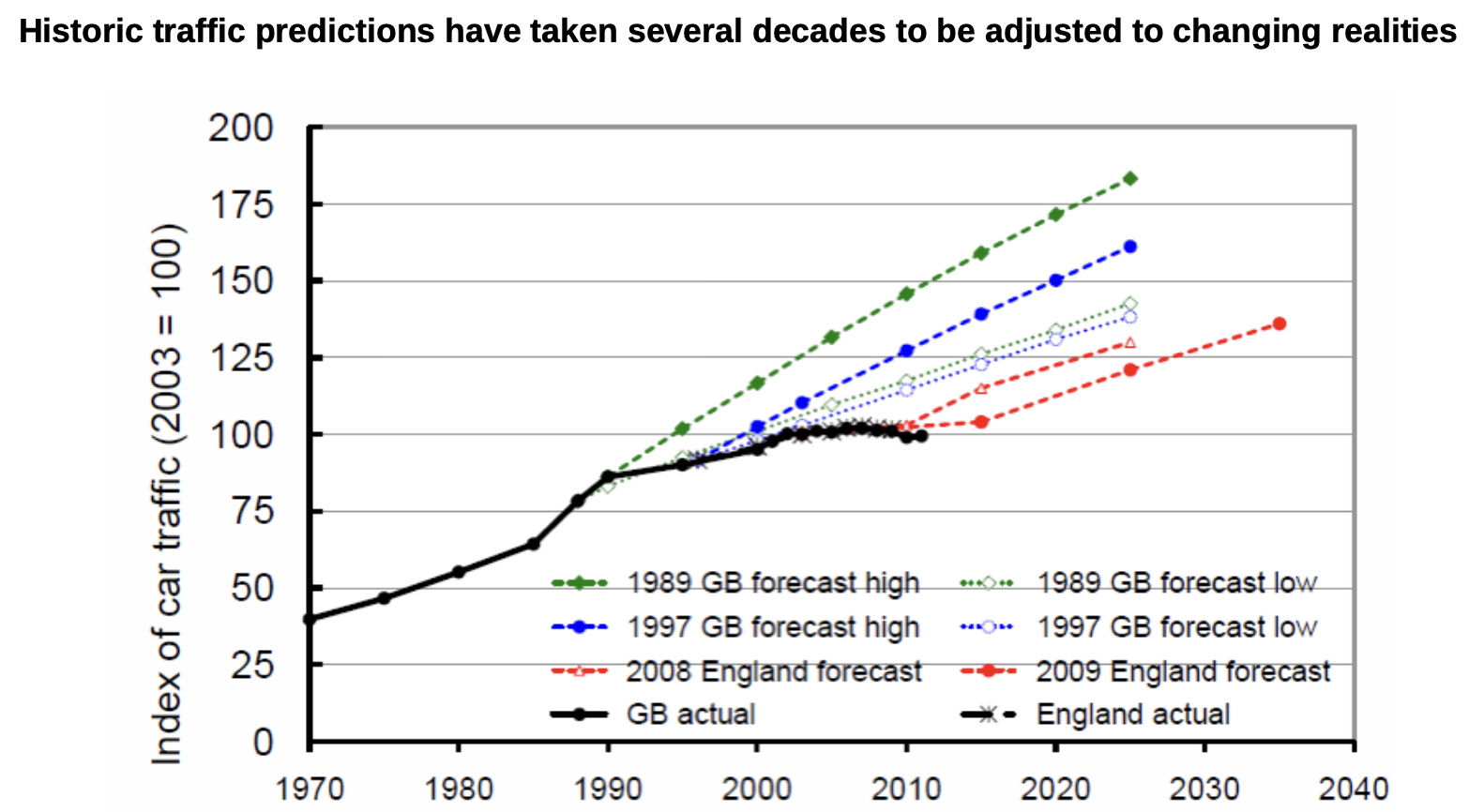
Source: Goodwin, P., (21 November 2021) Beyond Predict and Provide, International Transport Forum
Presentation (click to download)
A similar contention can be made about the impacts brought by the perceived ‘permanence’ of trams and fixed- track Rapid Transit Systems compared with ordinary buses. And the important contrary situation where the absence of suitable alternatives ‘locks people in’ to undesirable long-term patterns of behaviour. This speaks to the need for the early case-making process to map out people-centred scenarios for how the project might be used, understood and adapted in the future. The best long term transport planning, possesses both resilience and adaptability.
Future thinking and policy: who’s doing it well?
In respect of transport’s wider context, The Welsh Government’s ‘Well-being of Future Generations Act’ (2015)[5] stands out for its ambition and integration into the legal framework of the country, with a stated aim to “ensure that future generations have at least the same quality of life as we do now”. In the purest sense, it takes the original UN 1987 definition of sustainability from the Brundtland Report, “meeting the needs of the present without compromising the ability of future generations to meet their own needs[6]” and makes it clear that future people must have a stake in decision-making processes today. Multiple LTT/TAPAS articles could be dedicated to this topic, but for now, I suggest the excellent ‘Transport Fit for Future Generations’ report[7] from 2018 by the Welsh Government, Centre for Transport and Society (CTS), University of the West of England, Sustrans and New Economics Foundation which weighs up the long-term impacts of building new road infrastructure, and proposes alternatives that can unlock investment in public transport and active travel.
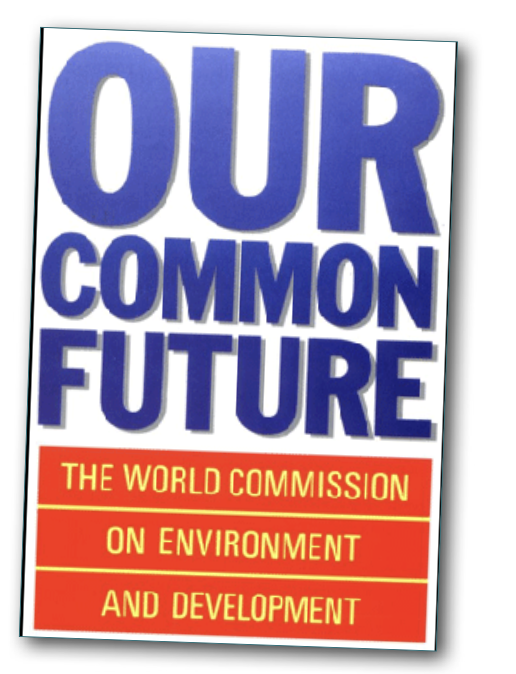
In 1987 the UN Brundtland Report Our Common Future suggested a definition of sustainability as “meeting the needs of the present without compromising the ability of future generations to meet their own needs”
Now 10 years old, a picture of the Welsh Wellbeing Act’s impacts is emerging. Decisions from road building, 20mph zones, walking and cycling policy, and even the Transport Appraisal formula, WelTAG, are all influenced by the backdrop of future generations. If pressed for a shortcoming, I get the impression not many people (in transport circles and the public outside Wales) know about the Act, or how it is connected to decision-making, so continued public (and professional) engagement could be needed to cement this link. Just as making Net Zero a legal requirement, the Act still requires ongoing political commitment when shorter term considerations come into play.
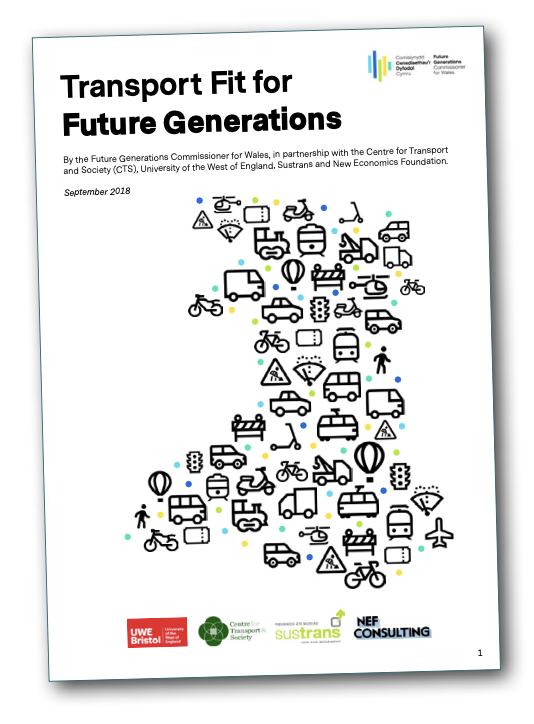
Transport Fit for Future Generations report by the Welsh Government, Centre for Transport and Society (CTS), University of the West of England, Sustrans and New Economics Foundation weighs up the long-term impacts of building new road infrastructure, and proposes alternatives unlocking investment in public transport and active travel
For its long-term vision, honourable mentions ought also go to the UKRI (UK Research and Innovation) ‘Transport Vision 2050[8]’ which sets out the research priorities for technology, society and behaviour that will surely guide how funding for academic and innovation research is allocated.
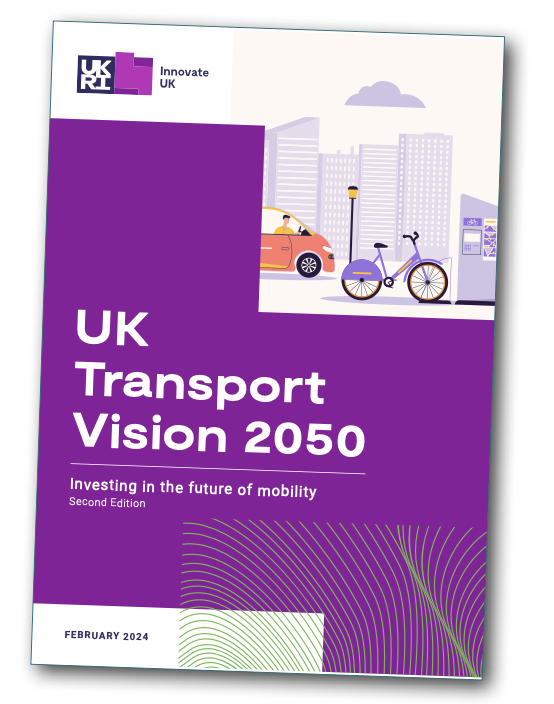
UK Research and Innovation’s Transport Vision 2050 sets out research priorities for technology, society and behaviour
For transport operators and the private sector, future planning boils down managing uncertainty in business cases, and I recommend the Mott Macdonald, GO-Science and DfT Futures Toolkit[9] as a way to structure any forward looking discussion and planning process to balance taking the longer view without descending into vague speculation or unrealistically specific detail.
One step forward: include children and young people in travel behaviour and policy research
The idea of including children and young people in travel behaviour and policy research is a good one, often commended but not always followed through or well executed. I’ve seen this recommendation arise from multiple angles – road safety, transport equity, climate change and public engagement – so I’ll make the point again, but from the wider argument of embracing long-term thinking. A failure to fully incorporate children into our transport research is a great shame, if nothing else because they clearly have a greater stake in the future than anyone else alive today. This sentiment is often expressed by many politicians and transport professionals, who are frequently quoted as saying their primary motivation is ‘to build a better world’ for their children and grandchildren (though it’s sometimes unclear if it’s just their kin, the plight of young people in general, or all young people as future adults that they are thinking of). Anyway, there is a strong emotional attachment to the idea of inter-generational thinking and responsibility, but perhaps not the deeper understanding of the issues, or a way of reforming the research and policy process system to reflect this perspective.
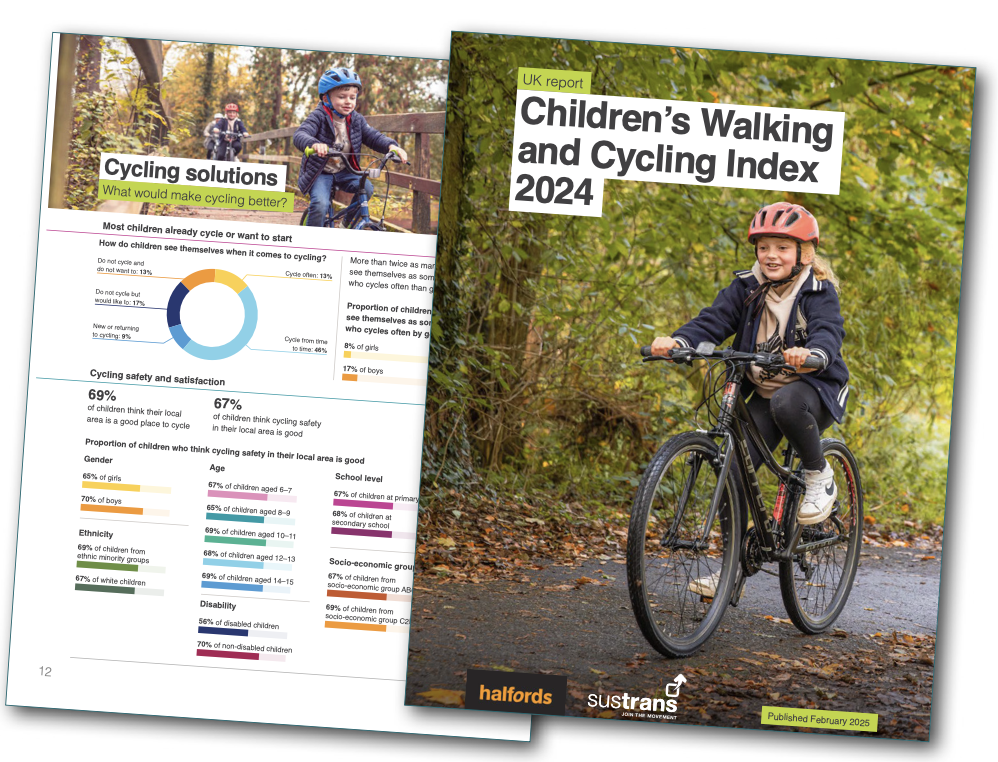
Earlier this year Sustrans published the Children’s Walking & Cycling Index [11], an independent survey of 1,089 children aged 6 to 15
In this regard it pays to understand the growing body of research on socialisation in transport, which shows how experiences now affect behaviour and attitudes later. Here are four major studies, covering topics like being car dependent when young, and bad public transport experiences conditioning future usage (Haustein et al. (2009) Germany, Verma et al. (2016) India, Muromachi (2017) Japan, Thigpen & Handy (2018) USA, Hopkins et al (2021) New Zealand).
Socialisation shows the importance of providing young people with high quality sustainable travel, not just because quality transport provides formative life opportunities, but also because it shapes future attitudes to expanding good quality transport in the future, and helps build positive habits, skills and abilities in early life for useful deployment later. Walking, cycling and making the best of public transport are skills people need to learn, experience and judge for themselves. The same has been said for ‘life skills’ beyond being able to read and write and add up, such as learning to swim, travelling independently, understanding inter-personal relationships and cooking, but with online connectivity there is an emerging risk these skills are assumed to attainable on demand.. Efficient and effective transport decision-making is no exception.
More directly, children and young people have a valuable fresh perspective on transport experience us professionals ought to incorporate. At present, children are left out of public engagement (except for occasional school participation on local plans), they seldom complete consultations (except for highly motivated parents completing on their behalf), and cannot vote (although the proposal to reduce the voting age to 16 years was in the Labour manifesto at the 2024 general election).
Research on children’s emergent attitudes, preferences and beliefs undoubtedly requires some special attention – like easy-read accessible explainers and careful study design – for which a full case is made by Professor Mary Kellet’s ‘Children as active researchers: a new research paradigm for the 21st century?[10] ’ written in 2005 but still as relevant today.
At a more fundamental level, the measurement of children’s travel behaviour still falls through the cracks of traditional research and data collection. For example, the National Travel Survey currently codes children using a micro-kick scooter, roller skates, balance bike and skateboards to get around as being part of the ‘walk’ mode activity, which is a shame, because it’s clear those technologies have unique appeal, they are often fun, help children travel further, and have several requirements that are different to walking (foremost, the value of hard smooth surfaces for little wheels, but associated personal safety issues). Personally, I would like to research the area of ‘invisible children’ further and would welcome collaborators getting in touch, as there remain a longer list of transport policies that leave children out of the equation.
Who is doing it well?
Earlier this year, Sustrans published the Children’s Walking & Cycling Index[11]. Its main contribution was an independent survey of 1,089 children aged 6 to 15, representative of the UK population, conducted in May 2024 as part of YouGov’s Children and Parents Omnibus Survey, usefully collecting attitudes and beliefs, not just travel behaviour. Then the Active Lives Survey[12] by Sport England and Ipsos outstanding for its coverage and open access, with the huge annual sample of nearly 200,000 adults extending to a bespoke Children and Young People survey administered in schools to 5-16 year olds. This tracks changes, annual data is openly available, it has a simple online tool and you can look within and between UK local authorities. Fresh data for 2024 has just been released in April this year and promisingly finds a significant growth in activity levels across the UK[13].
Conclusions
The plea for more long-term thinking in transport is not new, but I hope the arguments above may help bolster the case about both horizons, processes and content. At a fundamental level, the psychologists Stephen Reicher & Alex Haslam (2012)[14] explain the importance cognitive alternatives, that is our ability to even imagine how the future could be different, not just whether it should or will be different. This power is (probably) uniquely human, and the authors explain how leaders can inspire people to imagine change, and how our society and culture can shift between a present and future focus. None of this is set in stone, but I do believe there’s more work to be done in looking long-term, valuing the future differently, and that understanding the perspective of young people and generations to come is one of the ways to get there.
As you will note, the Netherlands is grappling with cycle safety too. But a question for us in Britain is whether we should carry on as we have been, trying to emulate the Dutch? We see e-bikes being heavily promoted in the UK these days. Should we carry on regardless under pressure from cycling activism? Or should we revert to data-led road safety interventions we know work, and keep a watchful eye on e-bike performance?
Britain used to have a data-led approach to road safety based on analysis and proper research. The Department for Transport (DfT) maintained a consistent approach requiring a thorough assessment of innovation. All that has changed. We see all manner of confusing, and apparently untested, road layouts appearing across the country, whereas we know that safer road layouts should be intuitive, understandable and self-explaining.
I welcome the new Transport Secretary Louise Haigh embarking on a fresh road safety strategy. A forensic examination of how we are doing on cycling would be helpful.
References and Links
-
Chatterton, T, and Newmarch, G., (2016 “The Future is Already Here, it’s Just Not Very Evenly Distributed.” Available from https://wp.lancs.ac.uk/everydayfutures/files/2016/08/chatterton_newmarch.pdf
-
House of Lords Library (17 March 2021) Government investment programmes: the ‘green book’ Available from https://lordslibrary.parliament.uk/government-investment-programmes-the-green-book/
-
University of Birmingham City REDI Blog (16 May 2024) Cheapening Tomorrow? Revisiting HM Treasury’s Discount Rate Available from https://blog.bham.ac.uk/cityredi/cheapening-tomorrow-revisiting-hm-treasurys-discount-rate/
-
Hazel, G., (12 April 2021) How land value capture is being used to help communities. Available from https://www.transportfornewhomes.org.uk/how-land-value-capture-is-being-used-to-help-communities/
-
Welsh Government - The Well-being of Future Generations Act https://www.gov.wales/well-being-of-future-generations-wales
-
United Nations (1987) Report of the World Commission on Environment and Development: Our Common Future Concise explanation available at https://www.britannica.com/topic/Brundtland-Report
-
Future Generations Commissioner for Wales (2018) Transport Fit For Future Generations Available from https://futuregenerations.wales/wp-content/uploads/2018/11/20180912-Transport-Fit-for-Future-Generations-C-1.pdf
-
UKRI (2021) UK Transport Vision 2050, Investing in the future of mobility Available from https://www.ukri.org/wp-content/uploads/2021/08/IUK-190324-UKTransportVision2050-2ndEdition.pdf
-
Government Office for Science (2024) The Future Toolkit Available from https://assets.publishing.service.gov.uk/media/66c4493f057d859c0e8fa778/futures-toolkit-edition-2.pdf
-
Kellett, M., (2005) Children as active researchers: a new research paradigm for the 21st century? Available from https://eprints.ncrm.ac.uk/id/eprint/87/1/MethodsReviewPaperNCRM-003.pdf
-
Sustrans (2024) Children’s Walking and Cycling Index 2024 Available from https://www.sustrans.org.uk/media/y2jatfzm/250224-waci24-childrensindexuk-v43_digital_v1a.pdf
-
Sport England (2025) Active Lives Available from https://www.sportengland.org/research-and-data/data/active-lives?section=methodology
-
Sport England (24 April 2025) Record numbers playing sport and taking part in physical activity https://www.sportengland.org/news-and-inspiration/record-numbers-playing-sport-and-taking-part-physical-activity
-
Reicher, S. D., & Haslam, S. A. (2012). Change we can believe in: The role of social identity, cognitive alternatives, and leadership in group mobilization and social transformation. IAP Information Age Publishing https://psycnet.apa.org/record/2012-27325-004.
Pete Dyson is a doctoral researcher at University of Bath and co-author of the book Transport for Humans: Are we nearly there yet? He was formerly Principal Behavioural Scientist at the Department for Transport (2020-22) and Senior Consultant at Ogilvy’s Behavioural Science Practice (2013-20). His PhD applies theories of psychology and societal transitions to understand travel behaviour and evaluate UK transport policy.
This article was first published in LTT magazine, LTT915, 15 May 2025.
You are currently viewing this page as TAPAS Taster user.
To read and make comments on this article you need to register for free as TAPAS Select user and log in.

Log in